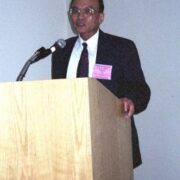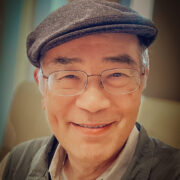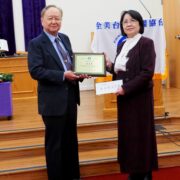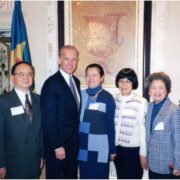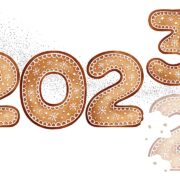The Story of Prof. Fong Y Tsai, MD, FACR
by Fong Y Tsai
My whole adult life has been blessed in many ways, after meeting with my wife (Jean) during my medical school year, my path suddenly changed in right direction. And those helping hands from my friends and teachers also and always came when my path is not smooth and perhaps with some blocks. Writing up my story is to express my heartfelt appreciation to those gave their hands to me from my friends and my teachers and also to my wife who has been behind the scene to assist me over the past half of century.
After graduation from Taipei Medical University in 1966, I was sent to Ma-Chu serving one year military service. During that time, I was asked (perhaps ordered) to be personal physician of deputy commander in chief of 19th Army Division. However, he was also so kind to take me with him when he went back to Defense Department for his promotion because he learned I was just married. During that trip, I had witnessed how US naval GI being pampered by US government, this experience made me high desire going to USA for my future life. After finished my military service, I was so lucky to enter my resident training in Taipei Veterans General Hospital in July of 1967. Initially, I was thinking to be a surgeon, but one of my three teachers, Dr.Tseun Chang had influenced me during my resident training and the reason for being a neuroradiologist.
In September of 1969, with a strong recommendation by my another teacher Dr.Chien-Ta Lu (from University of Chicago) and with blessing, I was accepted to Thomas Jefferson University Hospital for further and more formal training without internship. That second resident training was under chairman Dr.Philip J Hodes who was also the leading Neuroradiologist in USA at that time. However, my application of visa was blocked by Garrison Command Headquarter, perhaps from my family issue. Fortunately, my friend came to rescue to get the visa and resolved this very dangerous situation at that time. When my another teacher Dr.Chun Yu learned that I was going to Philadelphia, he even gave me his own collection of notebooks and journals summaries from University of Kansa to bring with me. Those summaries assisted me in many occasions during those weekly conferences and also helping me went through the training process. With those help, I was able to finish my four years resident training in three years and the final year turned into fellowship training in Neuroradiology. Toward the end of my fellowship training in 1973, I was recruited to Duke University, however, my chairman Hodes advised not to go there because he said deep south not good for me at that time. Then I was sent to Albany Medical College Hospital as chief of neuroradiology under Dr.John F Roach being chairman and also president of American Roentgen Ray Society.
In early 1976, Dr.Roach decided to retire, and chair of neurosurgery Dr.Richard Lende also suffered from injury. Dr.Lende introduced me to Dr.Ted Kurze who was chair of neurosurgery at USC medical center. In spring of 1977, I was transfer to USC and my family moved to San Mario. Due to the need of new interventional neuroradiology technics for helping him to treat those traumatic Carotid-Carvenous arteriovenous fistulas. Dr.Kurze sent me to Paris, France to learn this unique technic from Dr.Gerald Debrun. This new technic was not available in USA at that time. After coming back from Paris, I was then teamed up with Dr.Grant Hieshima of Harbor General Hospital to perform those interventional procedures in LA and Orange County. Dr.Hieshima and I were able to published several articles relating those new technics. We also published one text book-Neuroradiology of Head Injury. Despite those procedures were well supported by neurosurgeons but not from my own radiology department.
In middle of 1983,I was recommended to take a chair position at University Missouri at Kansa City, again, we moved away from LA. It was so fortunate to have Dr.James Mongan who was dean of UMKC school of medicine and director of Truman medical Center strongly supported to develop those newly established interventional neuroradiological procedures. And we also expanded to other new procedures with suppling new equipment. I became one of those pioneer in developing carotid angioplasty to treat carotid arterial stenosis from stroke without surgery. During my tenure in UMKC from 1983 to 1995, I had been interviewed many occasions as the following relating carotid angioplasty:
- Interview with American Cablevision, “Balloon Embolization and Carotid Angioplasty”, 1985.
- Interview with KMBC TV 9 Local ABC Affiliate, Kansas City, Missouri, “Balloon Embolization for Carotid Cavernous Fistula,” 1985.
- Interview with Cable News Network (CNN), “Percutaneous Transluminal Angioplasty of Carotid Artery,” August 7, 1985.
- Live Radio Broadcast “RSNA On the Air,” “Percutaneous Transluminal Angioplasty of Subclavian Steal Syndrome,” McCormick Place, Chicago, Illinois, November 19, 1985.
- Interview with Neurosurgery, Editor, Dr. Clark Watts, April, 1986.
- Interview with Medical World News, “Peripheral Angioplasty Comes into Fashion,” published December 14, 1987 issue.
One of early stroke center in USA was also established in Kansas City during the early eighty.
Radiology resident program was established in 1984 and Stroke Center was also established in 1986. During my tenure in UMKC, our team had published very extensively relating to newly developed carotid angioplasty and later leading to carotid stenting. My another textbook entitled Cerebrovascular Diseases was also published at this period of time.
In my heart,I have strong feeling to pay back to those teachers who taught and helped me at Taipei Veterans General teachers. in 1985, I was invited by my another teacher Dr.Tsuen Chang to demonstrate balloon embolization of carotid carvenous fistula technic. After that, the doors opened up for me to go back Taiwan more frequent to share my experiences with Taiwan colleagues and also open channel to accept fellowship from Taiwan and many current neurointerventional colleagues were from UMKC training. In the end of 1994, Dr.Mongan decided to take new post as president of Mass General Hospital practice and I was recruited to take chairmanship at Women Medical College and Hahnemann University as well as Graduate Hospital in January of 1995.
The merger of Women Medical College and Hahnemann University was named Allegany system, unfortunately, the system went bankrupt in 1997. The administrative and all chairs of the school worked very hard to stabilize and rescue the system during the bankrupt, however, the financial situation of the school was so irreversible. The hospital system was them sold to Tenet, but medical school was taken over by Drexel University in 1998. Again, my friend Dr.Anton M Hasso who was chair came to rescue me and offered to come back UCI in 1999. In the summer of 2000, I moved back to Southern California to join UCI.
After arrival to UCI in 2000, Dr.Thomas Cesario who was dean of school of medicine offered me a chairman position to rebuild department. Dr.Hasso was so kind to create Hasso Brothers Endow Chair for my chairmanship. During my chairmanship, again, friends of Nikken Corporation of Irvine kindly donated two million to our department. Without that donation we were probably not able to purchase urgently need updated CT, MRI and angiographic equipment just our own budget. Thus we built Nikken Outpatient Imaging Center to house CT and MRI. Another blessing event was during the process of establish women imaging endow chair to recruit the best women imaging radiologist to improve early diagnosis of breast and ovarian cancer of Asian women. In the beginning of setting up, UCI school of medicine took $3000 monthly, but I could not reach one million goal to formally establish the endow chair. Despite my strong efforts, only near to half million was raised but too far from one million goal. Those hard earning half million dollars might loose to general fund. Again many friends from Southern California, New Jersey and Taiwan stepped in and helped to raise more than half million in four months. Fortunately Women Imaging Endow Chair were able to establish in 2011 when I retired from UCI before going back to my Alma Matter-Taipei Medical University.
From the beginning of 2011,I went back to Taipei Medical University to develop Imaging research Center with Siemens Health System. With the strong support of TMU chairman of board Tseu-Der Lee and President Yun Yen, an Imaging Research Center(IRC) was established from 2011-2013. In July of 2013,during my vacation at Newport Beach home with my family, I got an urgent call from Taipei by Dr.Liang-Hsiung Lee who was director of Medical Team for former President Lee to treat vertebral arterial stenosis on July 6th,2013.After getting my renewed passport, I flew back to Taipei and arrived on July 11th.The procedure was performed and went smoothly at the eve of Typhon on July 12th. And few hours later, when I went to check on him, former president Lee was so kind and handed me his two recent written books. At the bedside of ICU, he even explained to me what the direction should be for Taiwan. This was the most highlight of my professional carrier. IRC was later also expanded to Translational Imaging Research Center (TIRC) in 2014 by Dr. Sandy Chang. Taiwan Radiological Society presented a 30 years teaching award at the time of finishing my obligation of IRC with Taipei Medical University. At this point, I had such satisfactory feeling in my professional carrier with 25 years of chairmanship over three major university hospitals and with several honors and decision came to me “It is time to retire from my medical profession”. In April of 2014,I packed my personal belongings but with few plates to fly back Orange County and taking as Volunteer faculty at UCI. It is so interesting to me, I recycled three times with UCI and finally closed my professional doors at UCI. Again, I received so much from friends, teachers and family, hope to pay back to them and others as I can.
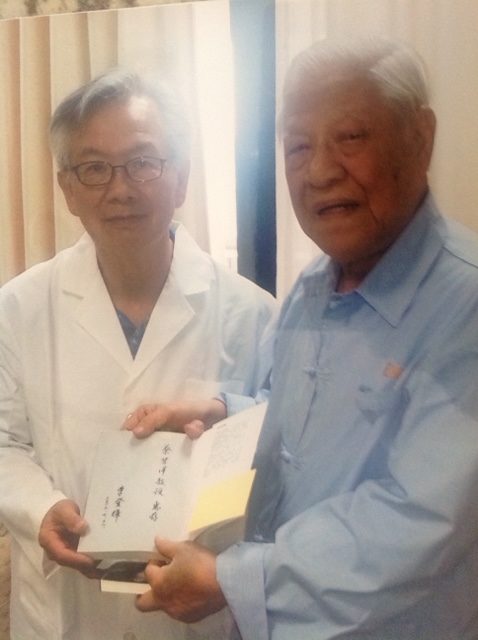
Prof. Tsai with President Lee of Taiwan after the surgery, Taipei, Taiwan, 07/2013

Investiture ceremony congratulates new chair holder and honors donors Dr. Fong and Jean Tsai Pictured from left : Dr. Stephen Feig, professor of radiological sciences and the director of breast imaging at UC Irvine Medical Center, who has been named the Dr. Fong & Jean Tsai Endowed Chair in Women’s Imaging; Dr. Fong Tsai and Dean Ralph Clayman on Oct. 5. Tsai was chair of the Department of Radiological Sciences from 2002-06. Feig is nationally and internationally recognized for his accomplishments in breast imaging research, his leadership in clinical mammography and his dedication to teaching.
Source from Prof. F. Tsai 08/2017
Posted in 08/2017

